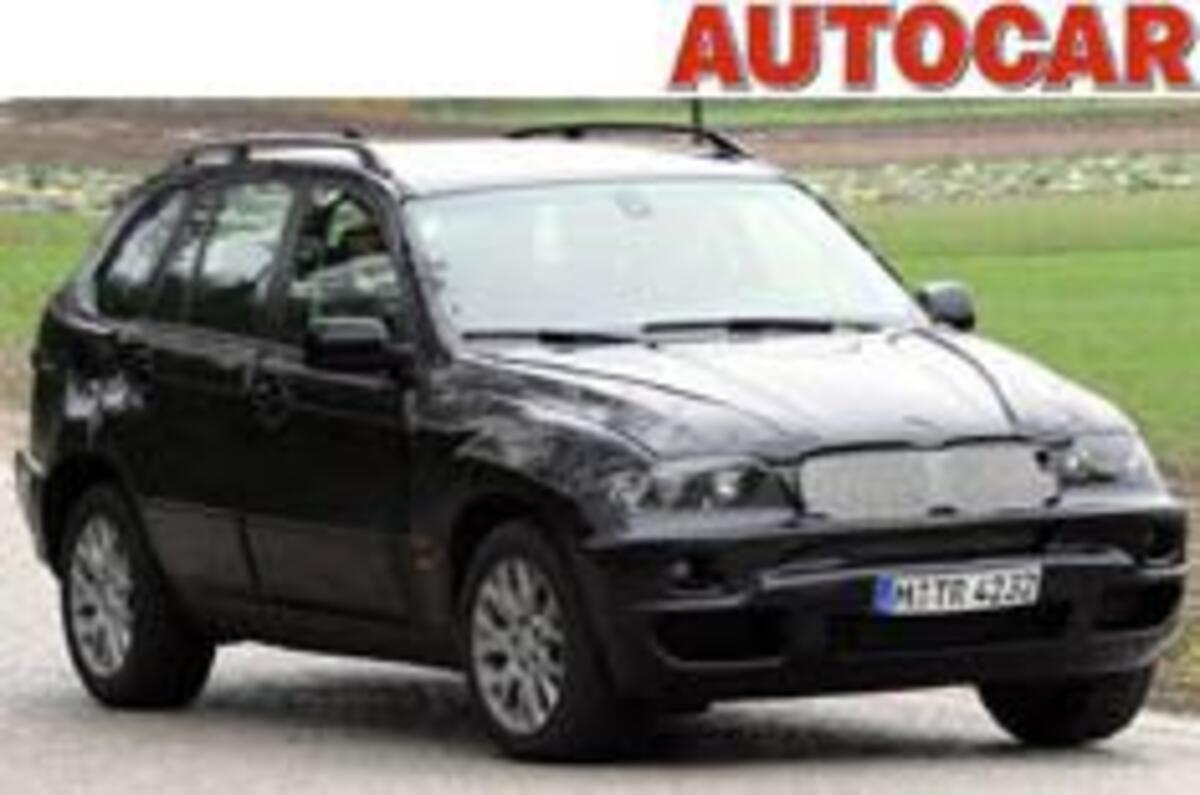The second-generation BMW X5 will be bigger, with more performance, comfort and versatility. The US-built 4x4 isn’t due to head into UK showrooms until the end of 2006, but in a world first Autocar has already caught the new seven-seater, with thinly-disguised production bodywork, testing near BMW’s headquarters in Germany. Our computer-generated cover image strips off the disguise worn by the early X5 prototype to reveal how the new model will look when it arrives in 18 months to do battle with the Land Rover’s Discovery 3, Merc’s new M-class and, as it moves upmarket, the Range Rover. BMW’s design team, headed by Dutchman Adrian van Hooydonk, don’t seem to have strayed too far from today’s X5: the shots appear to show a car less radical than the smaller X3 with which it shares a large percentage of its mechanical package. And the shape of the glasshouse and sloping split tailgate are highly reminiscent of today’s X5. Longer, wider and higher than today’s model, and with an extended rear overhang, the new X5 puts more distance between itself and the X3 than today’s model. This is expected to allow BMW to command higher prices. Nothing is official at this early stage, but increases of around £4000 are expected, taking the price of the entry level X5 3.0i close to £40,000 – almost £8000 more than the X3 3.0i.
Inside, the new X5 promises luxury on a level comparable to the 5-series. After receiving harsh criticism over the quantities and quality of the plastic inside the X3, BMW is taking measures to ensure the new X5’s interior is as good as the original’s. The big news, however, is the added space. Recognising the runaway success of seven-seat 4x4s, BMW has applied new packaging solutions to the X5 that look set to extend its versatility enormously. It will come as standard with five seats in a conventional 2+3 configuration, like today’s X5. However, buyers will be offered two additional seats as optional equipment to provide seating for up to seven in a 2+3+2 set-up similar to that adopted by the Volvo XC90, Land Rover Discovery and US-only Cadillac SRX. The two rear most seats have been made possible by a longer rear overhang that’s clearly evident in these photographs, as well as a total rethink of the X5’s interior packaging. When not in use the third row of seats fold away to increase luggage capacity, which grows from 465 litres to over 500 litres. Beneath its new bodywork and versatile interior, the X5 uses a new monococque platform that, Munich insiders suggest, is significantly more advanced than today’s structure whose origins can be traced back to the previous-generation 5-series. Related to the X3’s underpinnings, it supports new suspension using MacPherson struts up front and a multi-link arrangement at the rear to ensure the X5 retains its renowned car-like handling. Conventional steel springs will be used on lower-end models with air springs set to be fitted on upmarket versions, along with an automatic self-levelling feature to keep the ride height constant when towing. BMW will apply its Active Steering system to the new X5, a system particularly suited to a 4x4 as it helps prevent high-speed roll-over accidents, as well as improving manoeuvrability around town and, more crucially, high-speed stability, especially during lane changes.
Power will come from a wider range of in-line six-cylinder and V8 engines than offered in today’s model. Among the petrol units will be the recently upgraded 255bhp 3.0-litre six-cylinder. It will be joined from launch by new 4.0- and 4.8-litre V8 engines, presently under development in Munich as replacements for today’s 3.6 and 4.4-litre engines. Codenamed N62, they adopt a lightweight magnesium block and upgraded up versions of BMW’s Valvetronic and Vanos systems. The diesel line-up will include single- and twin-turbo versions of BMW’s excellent 3.0-litre six – both incorporating the latest injector technology for greater power and torque. Also planned is a new 4.0-litre V8 diesel engine.
Drive will be channelled permanently to all four wheels via either a six-speed manual (3.0i and 3.0d) or six-speed automatic (3.5d, 4.0i, 4.8i and 4.0d) and BMW’s xDrive four-wheel drive system. The electronically-controlled system, fitted to the current car earlier this year, automatically apportions drive between the front and rear axles according to information supplied by various sensors. The new X5 will also come with BMW’s Dynamic Stability Control, the latest four channel anti-lock braking as well as upgraded hill descent control. As with the first generation model, BMW has decided against serious off-roader features such as a separate transfer case, locking differentials and decoupling anti-roll bars. BMW engineers argue that the added weight would be detrimental to efforts to once again establish the X5 the most agile car in its class. ‘At the end of the day you have to ask the question: do the majority of potential customers really want such items? Our marketing studies suggest they don’t,’ said a source. The new X5 will again be assembled alongside the Z4 at BMW’s Spartanburg factory in South Carolina, USA. Despite increased competition and the appearance of the smaller (but cheaper) X3, BMW is bullish the X5’s future and suggests the record 101,000 production figure achieved in 2003 will be sustainable well into the new model’s lifecycle.




Add your comment